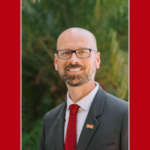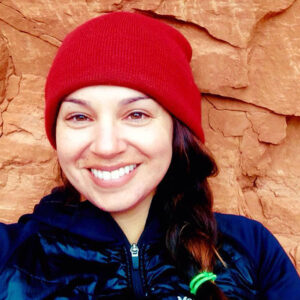
Carissa Baird, graduate of the TESL/TEFL teacher training program at SDSU’s American Language Institute
“What did I get myself into?!” was Carissa Baird’s first impression upon arriving in Riyadh, Saudi Arabia in 2013 to teach English as a second language. By the time she left, six months later, she would write on her blog:
From the expats to the locals, fellow teachers and students alike, I have experienced some of the most genuine kindness I’ve ever come across in my life … I’ve received countless gifts and other expressions of gratitude and kindness from people I’ve only known a few months, sometimes just a few hours. I’ve been invited to their homes, their workplaces, and their social gatherings. If they cannot offer you food, they will always be ready with a smile, a greeting, a kiss. Their generosity is compelling.
“The TESL/TEFL teacher training program at the ALI [SDSU’s American Language Institute] opened me up to a world that I didn’t even know existed,” said Baird. “Teaching English was just going to be a means for travel at the time I started, but I realized that it provided so much more. Not only have I been able to work and travel both domestically and abroad, but this certification made me realize that I LOVE teaching as a profession, and now I’m pursuing my master’s degree in TESOL (Teaching English to Speakers of Other Languages). The program at ALI put me in touch with some great people, including my assigned mentor who I still seek out for advice now, three years later.”
Baird shared her journey from trepidation to exhilaration:
Where did you go to school and how did you find out about the TESL/TEFL Certificate program at SDSU’s American Language Institute?
I graduated from San Francisco State University in 2010 with a B.A. in art with an emphasis in art history. In 2012, I heard about teaching English as a second-language and researched programs to obtain my teaching certificate. I enrolled in the ALI program in spring 2012 and completed it 11 weeks later. I was a facilitator in the ALI classes for a few months until I got my first job teaching abroad.
How does the program’s free worldwide job placement assistance work?
I would receive emails from Van [Hillier, program director] about teaching opportunities and apply for the ones I thought might be interesting. When the email for Saudi Arabia came through, I just thought … WHY NOT!? How many people do you meet that can say they lived there? So I went for it out of sheer curiosity and potential bragging rights. (And the money was good). Also, before I left, they put me in touch with another teacher that was also going, so it was nice to have someone else along for the ride.
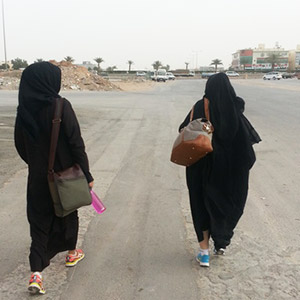
Baird (left) and another ESL teacher in Saudi Arabia walking to the main road from their apartment, on their way to the DQ — Riyadh’s Diplomatic Quarter. (“It was the only compound where we could run/exercise outside, without having to wear an abaya,” said Baird. “Note our running shoes, haha!”)
How soon after completing the program were you teaching English abroad?
Six months, however it could have been a lot sooner if I’d pursued it more aggressively.
Where did you live?
The company I worked for arranged our housing and had us staying in our own apartments, which was basically a long-term-stay hotel out in the middle of nowhere. We weren’t on a compound or anything. Our housing was paid for but we didn’t have a choice as to where/what it was.
What did a typical day look like?
Be picked up by a driver in a van full of other female teachers at 7 a.m. and be taken to Saudi Electronic University to start classes at 8 am. (There’s no mass transportation other than taxis, and women aren’t allowed to drive, so transportation was provided by the company.) When I first started I had only one class per week, but as time went on I had more and more classes both at the original school and then at Princess Nora University. Classes — with all female students — were about 2-4 hours long, depending on the class, and levels ranging from beginning to advanced.
Some days, toward the end of my stay, I would teach two or three classes and then go to my private tutoring classes in the evenings. (Which is exhausting after a full day of regular classes, but a good way to make extra cash.) But staying busy in Saudi Arabia was a blessing, as there wasn’t much else to do. After school, the driver would come back to pick us up and then drop us off at home, making several stops along the way since not all the teachers lived in the same place. Usually we would stay home after that, making dinner, watching TV, sleeping, or whatever.
KSA [Kingdom of Saudi Arabia] wasn’t too accommodating when it came to entertainment or other recreational activities, especially for single, Western women without family nearby. Going to the mall or the grocery store was a common outing, or any events that the foreign embassies were putting on in the evenings, which were lifesaving, but hard to get into.
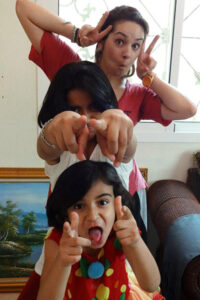
Baird with two of the four children she tutored privately in Saudi Arabia. (“I don’t have many photos from teaching in Saudi Arabia because the women weren’t allowed to take photos of their faces,” said Baird. “So mostly you get photos of their hands forming ‘peace’ signs. Children are allowed to be shown because they haven’t hit puberty yet and aren’t required to cover up.”)
Why were foreign embassy events hard to get into and what were they like?
Saudi Arabia is a “dry” country, so there is no alcohol or bars. Also, there are no movie theaters or live music/concerts (secular music) or dancing venues. A lot of the entertainment options we take for granted here are practically non-existent there, unless you have a hook-up at an embassy. The foreign embassies were like an underground social scene for expats in KSA. There were bars, live concerts, dancing and DJs, special dinners and festivals, etc. BUT to get into them, you usually had to have someone directly involved with the embassy to “sponsor” you, which basically meant they’d vouch for you to be allowed in, understanding that you wouldn’t do anything stupid. When you entered the event you had to be on a list, show a valid passport, check your cell phone at the door (no pictures allowed), then go through a physical screening process — metal detectors, etc. — before being allowed in. Once inside though, it’s like Pleasure Island from Pinocchio!
Were there TESL/TEFL instructors from other countries at your school?
Yes, there were instructors from the USA, the UK, Scotland, and even from Saudi Arabia, Jordan, and Oman. I’ve also met instructors from Australia and India.
Do you have anecdotes to share: small world occurrences, unexpected humor, places you explored?
Oh my gosh! I could go on and on about these things! Living abroad for the first time was insanely difficult in the beginning, but incredibly rewarding in the end. The cultural exchange and personal growth, as well as friendships that come out of it are invaluable. I have too many stories, but I’ll direct you to my blog: carissasade.tumblr.com.
An excerpt:
I met a guy in Saudi Arabia who happened to be staying at my hotel (although we weren’t really allowed to speak to each other) who was from San Diego, received his TEFL at ALI, went to school in San Francisco at the same time I was there, and then took his first job teaching abroad in Saudi with the same company as mine. We ended up becoming great friends and traveling together a lot. After losing touch for a year or two, we ran into each other again in San Diego, teaching at the same language school! SMALL WORLD INDEED!
How was the food?
Food in Saudi Arabia, when you can find the authentic stuff, is great! I really liked the traditional Saudi dish kabsa which is basically meat, rice, and sauce — but with lots of spice and flavors! Something typical that the girls would bring to class is Saudi “coffee,” which was basically cardamom tea that I grew accustomed to, but didn’t like at the beginning! This was usually accompanied by dates — a staple in the country — and lots and lots of sweets, candy, cakes, etc. Also, grape leaves stuffed with olives and drenched in olive oil were delish! However, it seemed that the more “popular” places to dine were American restaurant chains, ironically! Applebee’s and a cheesy Italian place called Pietto’s were hot spots. But sometimes when you’re craving a little bit of home, this was nice.
Tell us about some of the friendships you made.
Gosh, I’ve made a lot of great friends both with colleagues and students alike over the past few years. In Saudi Arabia, I made great friends with a few teachers — male and female — that I got to travel with a lot while we were there, to Dubai, Sri Lanka, and Bahrain. The students I’ve had at the schools I’ve taught at in the U.S. have had such a significant impact on me. I still talk to many of them even now, almost two years later, and they tell me about their marriages, their moves to other parts of the country, and their newest educational and professional endeavors. (Facebook is a wonderful tool in this field of work!)
What do you think are the biggest strengths of SDSU’s TESL/TEFL Certificate program at SDSU?
Taking a similar class right now, I have to say that the SDSU program completely surpasses it on so many levels. I liked the support both in and out of the classroom, and I enjoyed the variety of instructors whose strengths were highlighted in different presentations throughout the program. The variety in teaching and learning new strategies was so awesome! It was great to be able to learn straight from the experts of specific aspects involved in ESL teaching. Also, being able to schedule and observe classes at the ALI was so great! In the class I’m in now, we have to go out and try to find our own classes to observe, which can be grueling. The ALI program was very hands-on and helpful in finding me a job after the program, even if it was as a facilitator there at SDSU. I felt very prepared.
Where are you pursuing your master’s in TESOL and where would you like to teach?
CSU-Fullerton. I’m hoping to obtain this master’s to have the ability to teach at a community college or university here in California, however I might have it in me to go abroad once again! Not sure where, but the possibilities are endless and that excites me!
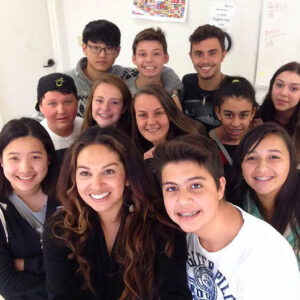
Baird and her students at International House – San Diego, a private language school in Fashion Valley where she worked after returning from Saudi Arabia.
Who was your mentor during the SDSU program and why do you still seek out him out for advice three years later?
Ken Levin was my mentor and yes, I still contact him from time to time, and even just meet up for coffee every once in a while! He’s great for intelligent conversation about the field and excellent advice. I’ve even had him help me out by writing recommendation letters for both graduate schools and professional opportunities. He’s always been super supportive and able to relate to the wacky world of international work.
Anything you’d like to add?
Teaching English has introduced me to some amazing people from all over the world that I’ve formed lasting friendships with — students, co-workers, and administrators. There’s a whole world of people that ESL teaching has opened me up to, with endless opportunities, and I’m so grateful that I fell into this amazing community! I really hope this helps and inspires anyone who is looking to go down this road. It seriously brings tears to my eyes and so much joy to think about what this little certificate has brought to my life! I’ve lived more in the last few years than most people have in their lifetime and I’m thankful to TESOL for providing me with the confidence and means to pursue these otherwise overlooked opportunities. Travel and teaching are two passions I never thought would guide my life’s path, but now, I can’t think of any other way. Thank you to ALI for being the catalyst to this life of adventure!
For more information on the 130-hour TESL/TEFL Certificate program at SDSU’s College of Extended Studies, visit ali.sdsu.edu/teslteflcertificate

